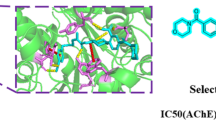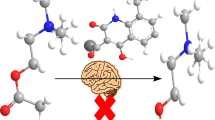Abstract
We have synthesized the tertiary amines of pyridostigmine and neostigmine, 3-pyridinol dimethylcarbamate (norpyridostigmine) and 3-dimethylaminophenol dimethylcarbamate (norneostigmine) respectively, and we have tested their abilities to cross the blood-brain barrier and inhibit mouse brainAChE activity. The in vivo inhibition of AChE activity by norpyridostigmine reaches 72% at 10 minutes which is comparable to that seen with physostigmine (73% at 10 minutes). Inhibition by norneostigmine is less effective (50% at 10 minutes) and approaches that obtained with tetrahydroaminoacridine (57% at 10 minutes). These data show that both norpyridostigmine and norneostigmine cross the blood-brain barrier and that they are effective inhibitors of mouse brain AChE activity. These drugs could be useful in the treatment of memory, impairment associated with Alzheimer's disease, and other memory disorders.
Similar content being viewed by others
References
Davis, P. 1979. Neurotransmitter-related enzymes in senile dementia of the Alzheimer's type. Brain Res 171:319–327.
Coyle, J. T., Price, D. L., DeLong, M. R. 1983. Alzheimer's disease: a disorder of cortical cholinergic innervation. Science 219:1184–1190.
Etienne, P., Dastor, D., Gauthier, S., et al. 1981. Alzheimer's disease: lack of effect of lechitic treatment of three months. Neurology 31:1552–1554.
Davis, K. L., Mohs, R. C. 1982. Enhancement of memory processes in Alzheimer's disease with multiple-dose intravenous physostigmine. Am. J. Psychiatry 139:1421–1424.
Davis, K. L., Mohs, R. C., Davis, B. M. et al. 1983. Oral physostigmine in Alzheimer's disease. Psychopharmacol Bull 19:451–453.
Thal, L. J., Masur, D. M., Sharpless, N. S., et al. 1986. Acute and chronic effects of oral physostigmine and lecithin in Alzheimer's disease. Prog Neuropsychopharmacol Biol Psychiatry 10:627–636.
Sano, M., Stern, Y., Stricks, L., and Mayeux, R. Physostigmine response in probable Alzheimer's disease is related to duration of exposure. Neurology (in press).
Summers, W. K., Majovski, L. V., March, G. M., et al. 1986. Oral tetrahydroaminoacridine in long-term treatment of senile dementia, Alzheimer's type. N Engl J Med 315:1241–1245.
Brufani, M., Marta, M., Pomponi, M. 1986. Anticholinesterase activity of a new carbamate, heptylphysostigmine, in view of its use in patients with Alzheimer-type dementia. Eur J Biochem 157:115–120.
Brossi, A., Schonenberger, B., Clark, O. E., and Ray, R. 1986. Inhibition of acetylcholinesterase from electric eel by (−)- and (+)- physostigmine and related compounds. FEBS Lett 201:190–192.
Irwin, R. L., Hein, M. M. 1962. The inhibition of rat brain cholinesterase after administration of the dimethylcarbamates of deoxy- demethyllycoramine, neostigmine or physostigmine. J Pharmacol Exp Ther 136:20–25.
Galli, A., Renzi, G., Grazzini, E., et al. 1982. Reversible inhibition of acetylcholinesterase by eseroline, an opioid agonist structurally related to physostigmine (eserine) and morphine. Biochem Pharmacol 31:1233–1239.
Kitz, R., Ginsburg, S., and Wilson, I. B. 1967. The reaction of acetylcholinesterase with O-dimethylcarbamyl esters of quaternary quinolinium compounds. Biochem. Pharmacol 16:2201–2209.
Johnson, C. D., and Russell, R. L. 1975. A rapid, simple radiometric assay for cholinesterase, suitable for multiple determinations. Anal Biochem 64:229–238.
Giacibini, E., and Holmstedt, B. 1958. Cholinesterase content of certain regions of the spinal cord as judged by histochemical and cartesian diver technique. Acta Physiol Scand 42:12–27.
Wilson, I. B., Hatch, M. A., and Ginsburg, S. 1960. Carbamylation of acetylcholinesterase. J. Biol Chem. 235:2312–2315.
Hsieh, J. Y., Yang, R. K., and Davis, K. L. 1983. High-performance liquid chromatographic determination of tetrahydroaminoacridine in human and rat tissues using a rapid Sep-pak C18 extraction. J Chromatogr 274:388–392.
Galli, A., Renjii, G., Bartolini, A., et al. 1979. Inhibition of [3H] naloxone binding in homogenates of rat brain by eseroline, a drug with analgesic activity, related to physostigmine. J. Pharm Pharmacol 31:784–786.
Author information
Authors and Affiliations
Rights and permissions
About this article
Cite this article
Arnal, F., Coté, L.J., Ginsburg, S. et al. Studies on new, centrally active and reversible acetylcholinesterase inhibitors. Neurochem Res 15, 587–591 (1990). https://doi.org/10.1007/BF00973747
Accepted:
Issue Date:
DOI: https://doi.org/10.1007/BF00973747




